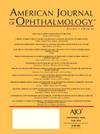Catering to the Era of Gene Therapy: An Objective Staging Strategy for Bietti Crystalline Dystrophy using Principal Component Regression
IF 4.1
1区 医学
Q1 OPHTHALMOLOGY
引用次数: 0
Abstract
Purpose
To devise a novel and objective staging strategy of Bietti crystalline dystrophy (BCD) for gene therapy.
Design
Development and validation of severity and staging assessments.
Methods
We screened out 127 BCD patients from a cohort of 2146 patients with inherited retinal diseases (IRDs). Our study analyzed 6 critical indicators: age, LogMAR BCVA, absent autofluorescence (AF) area, mottled AF area, and average retinal thickness in ETDRS 1 mm circle and 3 mm ring. Using Principal Component Regression (PCR), we developed a quantitative model termed the Bietti Crystalline Dystrophy Score for Severity Assessment (BCD-SA Score), integrating indicators for disease severity. Additionally, a corresponding staging system (BCD-SA Stage) was derived from this model. We assessed the efficacy of the BCD-SA Stage, comparing it to the traditional staging strategy through a paired-sample t-test and Cohen's Kappa (κ) for agreement evaluation.
Results
The patients’ mean age was 47.96 ± 10.1 years. Spearman correlation analysis and univariate linear regression demonstrated a strong correlation between all indicators and the disease stages defined by the traditional method (P < .001). Principal Component Analysis (PCA) addressed the multicollinearity among indicators, extracting 2 linear uncorrelated principal components (PCs, Factor 1 and Factor 2). These PCs were then used in a multiple linear regression model to develop the BCD-SA Score. Subsequently, a novel and objective staging system (BCD-SA Stage) was created, providing a more precise disease delineation.
Conclusions
We developed an innovative and objective scoring and staging strategy for BCD by integrating 6 variables and utilizing the PCR approach. This strategy advances BCD assessment and serves as a benchmark for the natural history evaluation and staging of other IRDs.
迎合基因治疗的时代:使用主成分回归对Bietti晶体营养不良症的客观分期策略。
目的:为Bietti结晶性营养不良(BCD)的基因治疗设计一种新颖客观的分期策略。设计:开发和验证严重性和分期评估。方法:从2146例遗传性视网膜疾病(IRDs)患者中筛选出127例BCD患者。我们的研究分析了6个关键指标:年龄、LogMAR BCVA、无自体荧光(AF)面积、斑纹AF面积和ETDRS 1mm环和3mm环的平均视网膜厚度。利用主成分回归(PCR),我们建立了一个定量模型,称为Bietti晶体营养不良严重程度评估评分(BCD-SA评分),整合了疾病严重程度的指标。并以此模型推导出相应的分期系统(BCD-SA分期)。我们评估了BCD-SA分期的疗效,并通过配对样本t检验和Cohen’s Kappa (κ)进行一致性评估,将其与传统分期策略进行比较。结果:患者平均年龄47.96±10.1岁。Spearman相关分析和单变量线性回归表明,所有指标与传统方法定义的疾病分期之间存在很强的相关性(p结论:我们通过整合六个变量并利用PCR方法开发了一种创新的客观的BCD评分和分期策略。这一战略促进了生物多样性的评估,并为其他鸟类自然历史评估和分期提供了基准。
本文章由计算机程序翻译,如有差异,请以英文原文为准。
求助全文
约1分钟内获得全文
求助全文
来源期刊
CiteScore
9.20
自引率
7.10%
发文量
406
审稿时长
36 days
期刊介绍:
The American Journal of Ophthalmology is a peer-reviewed, scientific publication that welcomes the submission of original, previously unpublished manuscripts directed to ophthalmologists and visual science specialists describing clinical investigations, clinical observations, and clinically relevant laboratory investigations. Published monthly since 1884, the full text of the American Journal of Ophthalmology and supplementary material are also presented online at www.AJO.com and on ScienceDirect.
The American Journal of Ophthalmology publishes Full-Length Articles, Perspectives, Editorials, Correspondences, Books Reports and Announcements. Brief Reports and Case Reports are no longer published. We recommend submitting Brief Reports and Case Reports to our companion publication, the American Journal of Ophthalmology Case Reports.
Manuscripts are accepted with the understanding that they have not been and will not be published elsewhere substantially in any format, and that there are no ethical problems with the content or data collection. Authors may be requested to produce the data upon which the manuscript is based and to answer expeditiously any questions about the manuscript or its authors.

 求助内容:
求助内容: 应助结果提醒方式:
应助结果提醒方式:


